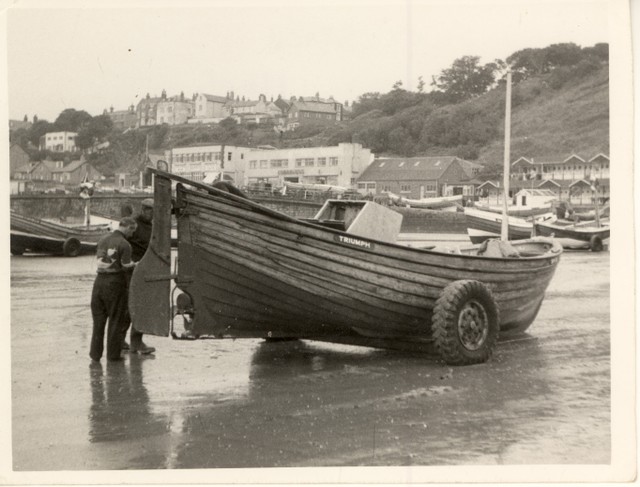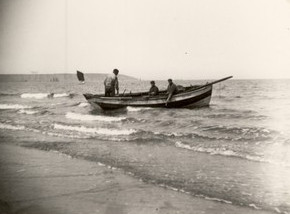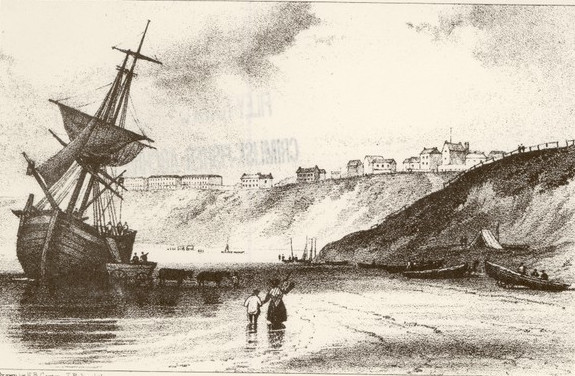
Menu:
Cobles, Yawls and more.
Filey has supported the fishing industry since at least 1180ad. The industry reached its peak in the mid nineteenth century when up to one hundred vessels could be seen in Filey bay. This fleet supported the employment of over 400 men, three quarters of the settled population of Filey. Various types of vessels used and based at Filey were herring cobles, winter inshore cobles, salmon cobles and the larger yawls and smacks.
A coble on Filey Beach 1960. Copyright © Crimlisk - Fisher Archive
The design of the
cobles is thought to have been based on the Viking longship. The
word coble itself has been in use for at least a thousand years, with
spelling more varied than can be pronounced for example ceubal
(Welsh) caubel (Breton) cobel (Celtic) and couple (Old
English/Saxon). The basic design developed over centuries to meet
the food demand of the population until having reached an optimum
shape for this coast, it remained unchanged. Flat bottomed, high
bowed and double keeled the cobles was made at first from oak, then
larch. It was rowed to the fishing grounds and the shape is ideal for
beaching on the shallow sandy shores of the north east coast. The
local fleet was also built locally mainly by the Cambridge, Chapman
and Cappleman families.
The last coble to built here was the “Windsor Lad II” IN 1949, by John Burrell.
This basic form and shape was used for all sail fishing fleet including the following vessels:
The Herring Coble, crewed by four men. Whilst generally smaller than a yawl or smack but a length of 42feet was recorded. These half decked ships had a cabin forward and fished off the Yorkshire coast until September when the herring moved away. They then long lined for cod, haddock and skate until Christmas when they laid up,
The Winter Inshore Coble, crewed by three. Fully open of about 22ft with one sail mast. These vessels worked up to six miles out to sea and off the Brigg in summer for lobster and crab.
The Salmon Coble the smallest of the cobles, fished with a net shot out. The Salmon Coble started from the beach andf was out and in before high water.
The first motor coble was built and launched in the town in 1913.

A Salmon Coble. Copyright © Crimlisk - Fisher Archive
Larger vessels:
The Smack or Ketch. This had a crew of four men and a boy, about 60-70ft long with two masts and sails. These were at sea Monday to Friday working Dogger Bank. The ships were mainly from Scarborough, Yarmouth and Lowestoft, but crewed by Filey men.
The Yawl. Owned by Filey men these mainly worked out of Scarborough with a crew of six men and two boys. Forty to sixty feet in length these vessels used cobles to long line fish off Dogger. They were also joined by Filey Cobles during the herring season. The successful design of the Yorkshire Yawls was developed by a Scarborough boat builder, Robert Skelton in 1834.

A Yawl beached at Filey about 1840 Copyright © Crimlisk - Fisher Archive
Many Yawls were lost in the great gale of 1860, amongst them “The Concord”, skippered by Richard Haxby and “Diligence” skippered by Edmund Cammish. The design was changed in 1870 to make them easier to handle, if slower.
The last Filey Yawl was “The Susie” sunk by a German submarine in 1917. The skipper, Mark Scotter was shot and killed by the enemy.
The unrelenting decline of the industry during the period following the end of the second world war has brought the end of economically viable commercial fishing in Filey.
© Crimlisk - Fisher Archive
Written by S Pinder and edited for the web by B Mulrine
Written by S Pinder and edited for the web by B Mulrine